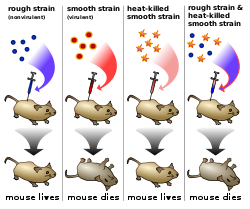Frederick Griffith
Frederick Griffith (1879–1941) was a English medical officer and geneticist. In 1928, during an experiment, he discovered what he called a transforming principle, but today we call DNA.[1][2]
Early life
He was born in Hale, Lancashire and attended Liverpool University where he studied genetics. In his younger days he worked at the Liverpool Royal Infirmary, the Thompson Yates Laboratory, and the Royal Commission on Tuberculosis.
Griffith's experiment
The experiment began when Griffith was trying to make a vaccine to prevent pneumonia infections in the "Spanish flu" influenza pandemic after World War I, by using two strains of the Streptococcus pneumoniae bacterium.
Later life
Griffith was killed at work in his laboratory in 1941, along with longtime friend and bacteriologist William M. Scott in London during an air raid in the London blitz. Years later Griffith's "transforming principle" was identified as DNA by Oswald Avery, along with coworkers Colin MacLeod and Maclyn McCarty, in 1944. The Avery–MacLeod–McCarty experiment.[3]
Frederick Griffith Media
Griffith's experiment discovering a "transforming principle" in heat-killed virulent smooth pneumococcus that enables the transformation of rough non-virulent rough pneumococcus. I am declaring this to be CC0. Although you are not legally required to do so, I would appreciate if you credit me (Madeleine Price Ball) when using my work. --Madeleine (talk) 02:18, 23 January 2013 (UTC)
References
- ↑ Lorenz MG, Wackernagel W (1994). "Bacterial gene transfer by natural genetic transformation in the environment". Microbiol. Rev. 58 (3): 563–602. doi:10.1128/mr.58.3.563-602.1994. PMC 372978. PMID 7968924.[dead link]
- ↑ Downie AW (1972). "Pneumococcal transformation--a backward view. Fourth Griffith Memorial Lecture". J. Gen. Microbiol. 73 (1): 1–11. doi:10.1099/00221287-73-1-1. PMID 4143929.
- ↑ Avery O, MacLeod C, McCarty M (1944). "Studies on the chemical nature of the substance inducing transformation of pneumococcal types. Inductions of transformation by a desoxyribonucleic acid fraction isolated from pneumococcus type III". J Exp Med. 79 (2): 137–158. doi:10.1084/jem.79.2.137. PMC 2135445. PMID 19871359.
{{cite journal}}: CS1 maint: multiple names: authors list (link)
Other websites
- Frederick Griffith Lancet, (3 May 1941): 588. Obituary
- The Famous DNA Experiments Archived 2009-01-30 at the Wayback Machine
- Griffith's Experiment on Bacterial Transformation Archived 2007-01-07 at the Wayback Machine

